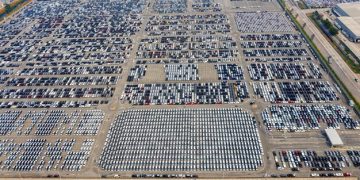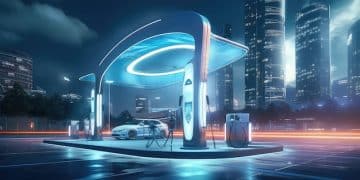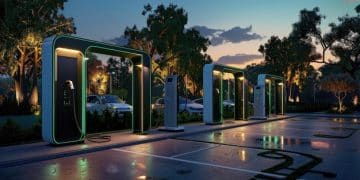Auto Sales Forecast Revised: 3% Decline Expected in 2025

A revised forecast indicates a 3% decline in auto industry sales for 2025 in the US, reflecting economic uncertainties, supply chain adjustments, and evolving consumer preferences impacting the automotive market.
The automotive industry is bracing for a potential slowdown, with a revised forecast indicating that auto industry sales are expected to decline by 3% in 2025. This projection has sparked considerable discussion among analysts, manufacturers, and consumers alike.
Revised Auto Sales Forecast for 2025: Key Factors
Understanding the nuances behind the revised auto sales forecast requires a close examination of several interconnected factors. This isn’t simply a matter of numbers; it’s about the broader economic landscape, changing consumer behaviors, and ongoing disruptions within the automotive sector itself.
Let’s delve into the primary drivers influencing this projected decline and what they mean for the future of car sales in the US.
Economic Uncertainty and Consumer Confidence
One of the major elements impacting the forecast is the overall economic uncertainty. Fluctuations in interest rates, inflation, and employment rates directly affect consumer confidence and their willingness to make significant purchases, such as vehicles.
When the economic outlook is murky, people tend to postpone or reconsider buying a new car. This hesitancy naturally translates into lower sales figures.

Supply Chain Adjustments and Production
The automotive industry has battled supply chain disruptions for several years, impacting production levels and availability. While constraints on semiconductors and other critical materials have eased, manufacturers are still adjusting their production strategies to meet demand effectively.
These adjustments may lead to temporary dips in sales as companies navigate inventories and optimize their output.
- Interest Rates: Higher interest rates make car loans more expensive, reducing affordability.
- Inflation: Rising living costs can divert consumer spending away from discretionary items like new cars.
- Employment: Job security influences consumer willingness to commit to large purchases.
Ultimately, the revised auto sales forecast reflects the complex interplay of these economic and industry-specific variables. Staying informed about these factors is crucial for anyone invested in the automotive market. In conclusion, the projected decline in auto sales is not an isolated event but a consequence of multiple factors, from economic conditions to industry-specific challenges. Understanding these drivers is essential for navigating the evolving automotive landscape.
Changing Consumer Preferences and Market Trends
Beyond economic and supply chain factors, shifting consumer preferences are playing a significant role in shaping the auto sales forecast for 2025. These evolving trends include the increasing adoption of electric vehicles (EVs), the growing popularity of SUVs and trucks, and the rise of shared mobility services.
Automakers must adapt to these changing demands to maintain their market share and avoid further sales declines. Let’s see what is expected by analysts.
The Rise of Electric Vehicles (EVs)
The transition to electric vehicles is accelerating, but the pace of adoption is not uniform. While EV sales are growing, they still represent a relatively small portion of the overall market. The infrastructure to support widespread EV adoption, such as charging stations, is not yet fully developed in many areas.
Factors like range anxiety, charging time, and the higher upfront cost of EVs continue to influence consumer decisions.
SUVs and Trucks Remain Popular
Despite the growing interest in EVs, SUVs and trucks continue to be the dominant vehicle types in the US market. Consumers often favor these larger vehicles for their versatility, safety features, and cargo capacity.
However, higher fuel prices and increasing environmental awareness could gradually shift demand toward more fuel-efficient options.

- EV Infrastructure: The availability and reliability of charging stations remain critical for EV adoption.
- Vehicle Preferences: Understanding consumer preferences for different vehicle types (sedans, SUVs, trucks, EVs) is essential for forecasting sales.
- Shared Mobility: The rise of ride-sharing and car-sharing services may impact individual car ownership rates.
In order for the automotive industry to thrive amidst these changing consumer demands, manufacturers must stay ahead of the curve. In summary, evolving consumer preferences, including the shift towards EVs and the continued popularity of SUVs and trucks, are crucial factors influencing the auto sales forecast for 2025. Adapting to these trends will be essential for automakers seeking to maintain their competitiveness.
Impact on Automotive Manufacturers
The projected 3% decline in auto sales for 2025 will have a ripple effect throughout the automotive industry, significantly impacting manufacturers. These companies will need to reassess their strategies, adjust production levels, and focus on profitability to navigate the challenging market conditions.
Here’s what’s at stake for the car makers.
Production Adjustments
Automakers will likely need to scale back production to align with the lower sales forecast. This could involve reducing shifts, temporarily idling plants, or streamlining operations to minimize excess inventory.
Efficient inventory management will be crucial to avoid overstocking and potential losses.
Focus on Profitability
In a declining market, profitability becomes even more critical. Manufacturers may need to prioritize higher-margin vehicles, cut costs, and improve operational efficiency to maintain healthy financial performance.
This could also involve focusing on aftermarket services and parts sales to generate additional revenue.
Strategic Partnerships and Alliances
Facing market headwinds, some manufacturers may seek strategic partnerships or alliances to share costs, access new technologies, or expand their market reach. Collaborations can help companies navigate the challenges more effectively.
These partnerships may involve joint ventures, technology sharing agreements, or even mergers and acquisitions.
The success of automotive manufacturers in 2025 will hinge on their agility, adaptability, and strategic decision-making. In conclusion, the revised auto sales forecast will necessitate production adjustments, a sharper focus on profitability, and potential strategic partnerships for automotive manufacturers. Adapting to these challenges is essential for ensuring long-term sustainability and success.
Government Regulations and Policies
Government regulations and policies play a crucial role in shaping the automotive industry and influencing auto sales forecasts. Emissions standards, fuel economy regulations, and incentives for electric vehicles can significantly impact consumer behavior and manufacturer strategies.
As a result, it’s imperative to understand the impact of the latest regulations.
Emissions Standards and Fuel Economy
Increasingly stringent emissions standards and fuel economy regulations are driving manufacturers to invest in cleaner technologies, such as electric vehicles and hybrid powertrains. These regulations can also influence the types of vehicles that are available in the market.
Compliance with these standards is essential for manufacturers to avoid penalties and maintain access to key markets.
Incentives for Electric Vehicles
Government incentives, such as tax credits and rebates for electric vehicle purchases, can significantly boost EV sales. These incentives help to offset the higher upfront cost of EVs and make them more attractive to consumers.
The availability and generosity of these incentives can vary by region and can have a direct impact on EV adoption rates.
Infrastructure Investments
Government investments in EV charging infrastructure are crucial for supporting the growth of the electric vehicle market. These investments can help to alleviate range anxiety and make it easier for consumers to switch to EVs.
The availability of convenient and reliable charging stations is a key factor in driving EV adoption.
In summary, government regulations and policies, including emissions standards, incentives for electric vehicles, and infrastructure investments, exert a significant influence on the automotive industry and auto sales forecasts. Staying informed about these policies is essential for understanding the future direction of the market.
Regional Variations and Market Segmentation
Auto sales forecasts must also account for regional variations and market segmentation. Consumer preferences, economic conditions, and regulatory environments can differ significantly across regions, influencing the types of vehicles that are popular and the overall sales performance.
Let’s see what these trends might bring.
Urban vs. Rural Markets
Urban and rural markets often have distinct vehicle preferences. Urban dwellers may prioritize fuel efficiency and smaller vehicles suitable for navigating congested streets, while rural residents may favor larger trucks and SUVs for their utility and off-road capabilities.
Automakers need to tailor their product offerings to meet the specific needs of each market.
Geographic Differences
Geographic differences in climate, terrain, and road conditions can also influence vehicle preferences. For example, all-wheel-drive vehicles may be more popular in regions with snowy winters, while convertibles may be more common in sunny coastal areas.
Understanding these regional variations is essential for accurate sales forecasting.
Demographic Segmentation
Demographic factors, such as age, income, and family size, can also play a role in shaping vehicle demand. Younger buyers may prioritize affordability and technology, while older buyers may focus on safety and comfort.
Automakers need to understand these demographic trends to develop effective marketing strategies.
In conclusion, regional variations and market segmentation are important considerations in auto sales forecasting. Understanding these differences can help automakers tailor their product offerings and marketing strategies to maximize sales performance and thrive, despite the decrease in auto sales.
Technological Advancements and Innovation
Technological advancements and innovation are continuously transforming the automotive industry, influencing everything from vehicle design and performance to consumer expectations and purchasing decisions. These trends must be considered when forecasting auto sales.
Here’s the impact of the techological improvements.
Autonomous Driving Technology
The development of autonomous driving technology has the potential to revolutionize the automotive industry. While fully autonomous vehicles are not yet widely available, advanced driver-assistance systems (ADAS) are becoming increasingly common.
These technologies can enhance safety, improve fuel efficiency, and offer new levels of convenience.
- Market Segmentation: Different regions have unique preferences and economic conditions that impact sales.
- Consumer Preferences: The shift toward electric vehicles (EVs) and the ongoing popularity of SUVs are crucial.
- Economic Factors: Economic uncertainty and supply chain adjustments are significant drivers.
Connectivity and Infotainment
Connected car technologies, such as over-the-air updates, infotainment systems, and smartphone integration, are becoming increasingly important to consumers. These features can enhance the driving experience and provide access to a wide range of services and information.
Automakers are also exploring new business models based on connected car services, such as subscription-based features and data analytics.
Alternative Powertrains
In addition to battery electric vehicles, other alternative powertrains, such as hydrogen fuel cells and plug-in hybrids, are also gaining traction. These technologies offer different advantages and may appeal to different consumer segments.
The development of a diverse range of alternative powertrains is essential for reducing emissions and meeting the evolving needs of the market.
In summary, technological advancements and innovation are key drivers of change in the automotive industry, impacting auto sales forecasts and shaping the future of mobility. Automakers must embrace these trends to remain competitive and meet the evolving expectations of consumers.
| Key Point | Brief Description |
|---|---|
| 📉 Sales Decline | Expected 3% drop in auto sales for 2025 due to economic factors. |
| ⚡ EV Adoption | Increasing but uneven adoption of electric vehicles influences market trends. |
| 📊 Market Factors | Economic uncertainty, supply chain adjustments, and regulation impact sales. |
| 🤝 Manufacturer Impact | Automakers must adjust production, focus on profitability, and consider partnerships. |
FAQ
▼
The primary reason is the confluence of economic uncertainties, including inflation, interest rates, and supply chain adjustments, which all impact consumer confidence and purchasing power in the automotive sector.
▼
EV adoption is increasing, but the pace is uneven. Infrastructure limitations and higher upfront costs relative to traditional vehicles influence the rate at which consumers switch to electric.
▼
Manufacturers can reassess strategies by aligning production levels with the revised forecast, prioritizing profitability through higher-margin vehicles, and exploring collaboration to share costs and improve tech access.
▼
Government regulations and incentives, such as emissions standards, fuel economy regulations, and tax credits for EV purchases, play a key role in shaping manufacturer strategies and consumer behavior.
▼
Yes, SUVs and trucks remain popular, despite the EV transition. They are favored for their versatility, safety, and cargo capacity, but this trend could shift with evolving consumer awareness and rising gas prices.
Conclusion
In conclusion, the revised forecast of a 3% decline in auto industry sales for 2025 reflects a complex interplay of economic uncertainties, changing consumer preferences, and technological advancements. Automotive manufacturers must adapt their strategies to navigate these challenges and maintain long-term success in a rapidly evolving market.





